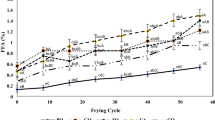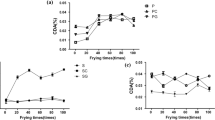Abstract
The effects of different frying methods; frying under atmospheric condition and frying in the presence of different ratios of nitrogen and carbon dioxide gases; were investigated on chemical changes of canola oil. The tests were conducted four times per day during four consecutive days. The chemical changes of oil samples were determined by analyzing peroxide value (PV), p-anisidine value (p-AV), totox value (TV) and acid value (AV). Irrespective of the test methods, PV increase was observed on the first day followed by significant (p < 0.05) reduction in the subsequent days. On the first day, the highest p-AV and TV was observed in oil fried under atmospheric condition and the lowest p-AV and TV for those fried under gases. However, from the second day, the p-AV and TV in frying under different ratios of nitrogen and carbon dioxide gases were significantly (p < 0.05) higher than the frying under atmospheric condition. Additionally, hydrolysis and oxidation of oil during frying resulted in continuous AV increase that among them atmospheric frying had the highest AV. In conclusion, atmospheric frying accelerates the rate of oil deterioration and application of nitrogen and carbon dioxide gases in the fryer could reduce the rate of oil disintegration.





Similar content being viewed by others
References
Gupta MK (2005) Frying oils. In: Shahid F (ed) Bailey's industrial oil and fat products. Wiley, New Jersey, p 1981, 1992
Kochhar SP (2001) The composition of frying oils. In: Rossell JB (ed) Frying: improving quality. CRC Press, Boca Raton, p 87
Choe E, Min DB (2007) Chemistry of deep-fat frying oils. J Food Sci 72:77–86
Perkin EG (1992) Effect of lipid oxidation on oil and food quality in deep frying. In: St Angelo AJ (ed) Lipid oxidation in food. Am Chem Soc, Washington DC, pp 310–312
Andrikopoulos NK, Kalogeropoulos N, Falirea A, Barbagianni MN (2002) Performance of virgin olive oil and vegetable shortening during domestic deep-frying and pan-frying of potatoes. Int J Food Sci Technol 37:177–190
Naz S, Siddiqi R, Sheikh H, Sayeed SA (2005) Deterioration of olive, corn and soybean oils due to air, light, heat and deep frying. Food Res Int 38:127–134
Pambou-Tobi NP, Nazikou JM, Mastos L, Ndangui CB, Kimbonguila A, Abena AA, Silou Th, Scher J, Desobry S (2010) Comparative study of stability measurements for two frying oils: soy bean oil and refined palm oil. Adv J Food Sci Technol 2(1):22–27
Tsuzuki W, Matsuoka A, Ushida K (2010) Formation of trans fatty acids in edible oils during the frying and heating process. Food Chem 123:976–982
Sunisa W, Worapong U, Sunisa S, Saowaluck J, Saowakon W (2011) Quality changes of chicken frying oil as affected of frying conditions. Int Food Res J 18:606–611
Przybylski R, Eskin NAM (1988) A comparative study on the effectiveness of nitrogen or carbon dioxide flushing in preventing oxidation during the heating of oil. J Am Oil Chem Soc 65:629–633
Aladedunye FA, Przybylski R (2009) Protecting oil during frying: a comparative study. Eur J Lipid Sci Technol 111:893–901
Shyu SL, Hau LB, Hwang LS (1998) Effect of vacuum frying on the oxidative stability of oils. J Am Oil Chem Soc 75:1393–1398
Augustin MA, Lee KH, Yau KT (1987) Comparison of the frying performance of market samples of palm olein, corn oil and soya oil in Malaysia. Pertanika 10(3):295–304
Augustin MA, Heng LK, Idris NA (1988) Evaluation of potato crisps fried in market samples of palm olein, corn oil and soy oil. Pertanika 11(3):393–398
Tyagl VK, Vasishtha AK (1996) Changes in the characteristic and composition of oil during deep-fat frying. J Am Oil Chem Soc 73:499–506
Amany MMB, Shaker MA, Azza AAA (2012) Vacuum frying: an alternative to obtain high quality potato chips and fried oil. Glob Adv Res J Microbiol 1(2):19–26
Pavlista AD, Ojala JC (1997) Processing vegetable commodities. In: Smith DS, Cash JN, Nip WK, Hui YH (eds) Processing vegetables: science and technology. CRC Press, Florida, p 279
ISO 3960 (2007) Animal and vegetable fats and oils—determination of peroxide value—Iodometric (visual) end point determination
ISO 6885 (2006) Animal and vegetable fats and oils—determination of anisidine value, 3rd edn
ISO 660 (1996) Animal and vegetable fats and oils—determination of acid value and acidity, 2nd edn. International organization for standardization, Geneva
Warner K (2008) Chemistry of frying oils. In: Akoh CC, Min DB (eds) Food lipid chemistry, nutrition and biotechnology, 3rd edn. CRC Press, Florida, p 207
May WA, Peterson RJ, Chang SS (1983) Chemical reactions involved in deep-fat frying of foods: identification of the volatile decomposition products of triolein. J Am Oil Chem Soc 60:990–995
Houhoula DP, Oreopoulou V, Tzia C (2002) A kinetic study of oil deterioration during frying and a comparison with heating. J Am Oil Chem Soc 79:133–137
Nawar WW (1996) Lipids. In: Fennema OR (ed) Food chemistry, 3rd edn. Marcel Dekker, New York, p 258
Serjouie A, Tan CP, Mirhosseini H, Che Man YB (2010) Effects of vegetable- based oil blends on physicochemical properties of oils during deep-fat frying. Am J Food Technol 5(5):310–323
Acknowledgments
The authors would like to acknowledge the Behshahr Industrial Company, particularly, Mr. Ghasemi and Mr. Eslami for their technical guide and support.
Author information
Authors and Affiliations
Corresponding author
About this article
Cite this article
Nazarbakhsh, V., Ezzatpanah, H., Tarzi, B.G. et al. Chemical Changes of Canola Oil During Frying Under Atmospheric Condition and Combination of Nitrogen and Carbon Dioxide Gases in the Presence of Air. J Am Oil Chem Soc 91, 1903–1909 (2014). https://doi.org/10.1007/s11746-014-2539-6
Received:
Revised:
Accepted:
Published:
Issue Date:
DOI: https://doi.org/10.1007/s11746-014-2539-6




